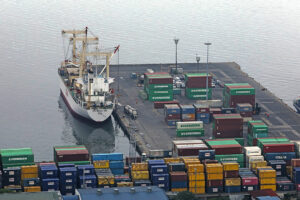By Beatriz Marie D. Cruz, Reporter
THE PHILIPPINES’ trade deficit narrowed year on year in April but posted the widest level in five months, as exports and imports posted double-digit growth, the statistics agency said on Tuesday.
Preliminary data from the Philippine Statistics Authority (PSA) showed the country’s trade-in-goods balance — the difference between exports and imports — stood at a $4.76-billion deficit in April, 1.5% lower than the $4.83-billion gap in the same month in 2023.
Month on month, the trade gap widened from the $3.44-billion deficit in March.
The April trade deficit was the widest in five months or since the $4.77-billion gap in November last year.
For the January-to-April period, the trade deficit shrank by 15.7% to $16.27 billion from the $19.29-billion gap a year ago.
In April, the value of exports jumped by 26.4% to $6.22 billion from $4.92 billion a year ago.
This was the fastest annual exports growth in 35 months or since 30.9% surge in May 2021.
On the other hand, the value of imported goods rose by 12.6% to $10.98 billion in April, from $9.75 billion a year ago. This was the quickest rise in imports in 19 months or since the 14.4% growth in September 2022.
The Development Budget Coordination Committee (DBCC) projects 3% and 4% growth in exports and imports, respectively, this year.
WEAK PESOThe import and export bills in April were at their highest in five months, amid the peso depreciation.
In mid-April, the peso sank to the P57-per-dollar level for the first time since November 2022. The peso weakened by P1.52 or 2.7% to close at P57.76 per dollar on April 30 from its P56.24 finish on March 27.
“The weaker peso made exports cheaper in international markets… but made imports more expensive though offset by the temporary spike in global crude oil and other global commodity prices at the height of the Israel-Iran tensions/geopolitical risks in April 2024,” Rizal Commercial Banking Corp. Chief Economist Michael L. Ricafort said in an e-mailed note.
Sunny Liu, lead economist at Oxford Economics, said the weaker peso may bolster export competitiveness but the “strong US dollar” is a main theme across the region, which means other currencies are also weak.
“Therefore, the relatively competitiveness gained could be smaller. Furthermore, the benefit from weaker peso might be offset by higher costs of imported inputs or raw materials needed for production,” she said in an e-mail.
Manufactured goods, which accounted for 80.2% of the country’s total export receipts, increased by 27.7% to $4.99 billion in April from $3.91 billion in the same month last year.
Electronic products, which made up most of manufactured goods, jumped by 33.3% to $3.57 billion in April.
Semiconductor exports rose by 30.6% to $2.76 billion in April.
Exports of mineral products rose slightly at 6.7% to $546.52 million in April.
Hong Kong unseated the United States as the top destination of Philippine-made goods in April with $1.03 billion in export value, accounting for 16.5% of the total exports.
United States fell to second spot with $948.43 million in export value (15.3% of the total) followed by Japan ($823.27 million or 13.2%), China ($702.02 million or 11.3%) and South Korea ($314.59 million or 5.1%).
“Demand from Hong Kong is picking up rapidly, while shipments to the US continue to regain upward momentum steadily, offsetting the sluggishness in exports to China, which continued at the start of quarter two,” Pantheon Macroeconomics Chief Emerging Asia Economist Miguel Chanco and Senior Asia Economist Moorthy Krshnan said in an e-mail.
Meanwhile, imports of raw materials and intermediate goods grew year on year by 14.3% to $4.09 billion in April. This accounted for more than a third or 37% of total imports.
Imported capital goods rose by 10.5% to $3.1 billion, while imported consumer goods jumped by 15.7% to $2.07 billion.
Imports of mineral fuels, lubricants and related materials increased by 8.4% to $1.66 billion in April.
“The April rise (in imports) was broad-based and fairly robust across-the-board. It will take more than a single month of good data, however, to stop imports of consumer goods from rolling over further,” Pantheon Macroeconomics economists said.
China was the biggest source of imports valued at $3.15 billion, accounting for 28.7% of the total import bill in April.
It was followed by Indonesia ($959.21 million or 8.7% of the total), Japan ($909.54 million or 8.3%), South Korea ($743.11 million or 6.8%) and the United States ($726.20 million or 6.6%).
